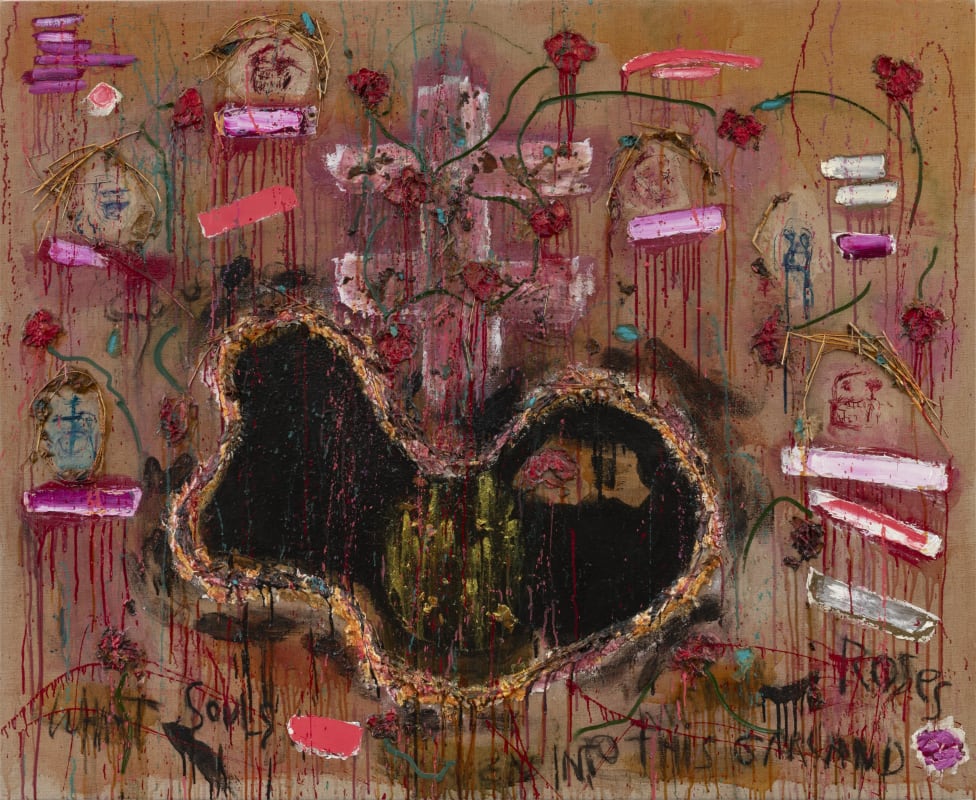Joan Snyder by Kendall DeBoer Love is part of the practice
At eighty-four years old, Joan Snyder has had a career spanning decades. Her riotous, colorful paintings are as varied and experimental as they are dense with interpretive possibility. Snyder’s suggestive materials—like burlap, velvet, rosebuds, glitter, fake fur, berries, wallpaper, fringes, and plastic grapes, to name a few—adorn her canvases, rife with emotional intensity and complexity. For this interview, I approached Snyder’s paintings as containing the spirit of a bouquet or a wreath. Both are just as much festive party favors as they are solemn funerary devices. Like Snyder and her work, they blur the lines between nature and artifice, and conjure associations ranging from personal and domestic to ritualistic and sacred.
Kendall DeBoer Your stroke paintings from the early 1970s are well known, but you also created experimental, unconventional work before then. Could you tell me about your paintings from the mid- and late 1960s?
Joan Snyder Those paintings used a lot of different materials, including flock. I don’t know where that all came from, but I started using collage elements very early on and then abandoned them completely to do the stroke paintings. The stroke paintings were descendants of the flock paintings. There were even grids and strokes in some flock paintings, but the ’70s stroke paintings ultimately used no collage elements. Then, in the mid-’70s, the material elements reemerged in the work. I think it had to do with feminism having entered the conversation and the need to embellish the canvas with more.
The ’60s paintings were about female sensibility, using lentil seeds, threads, and flocking, and creating membranes and very delicate pink areas. That was me putting the feelings that were inside me into a painting—what I was feeling about women, women’s bodies, and being a woman. Then, in the mid-’70s, I made Heart On (1975), a definite breakthrough painting for me.
KD What made Heart On a breakthrough?
JS I was using the grid to make squares, filling in the grids, making multi-paneled works. Heart On was addressing the feminine and sexuality. I was just beginning to get romantically involved with a woman. I was bringing together images of circles, hearts, and breasts. And I turned back to the materials I had stopped using in the ’60s for this painting. It was about a female sensibility, the feelings of a woman and of sexuality. Larry Fink and I sat in my studio in Martin’s Creek, probably smoking a joint, and titled the painting Heart On, a very amusing title.
KD While at Rutgers, you made a plaster angel sculpture adorned with fringe and plastic flowers, and a series of altar paintings. Did this style come out of your experience as a woman?
JS This was before any female sensibility discussion, but that feeling was part of my being and my art early on. In ’64, ’65, ’66, there were things going on in my life that are reflected in the work. Robert Morris was my sculpture teacher. We’re talking about Minimalism. For me, the angel was a rejection of the minimal. The angel was, obviously, like, Come on, Morris, I’m not going to sit and make a gray box like everyone else in the class. And I remember that he was astounded by my angel.
KD Do you ever think about your work in relation to sentimentality or kitsch? Like a valentine or a plaster saint?
JS It’s not kitsch; it’s humor. It’s my sensibility. My work sometimes has humor on top of everything else. The altar paintings were quite serious. When I wrote my MFA thesis, I said that my work was my religion. This was my altar, where I go to worship, humor and all.
KD I’ve seen your work referred to as maximalist before. Is that title something you embrace?
JS You could call me a maximalist in the sense that my work uses lots of materials; it’s psychological; it often has content beyond the field or the stroke; and it packs a lot of information into one painting.

















































































































































































